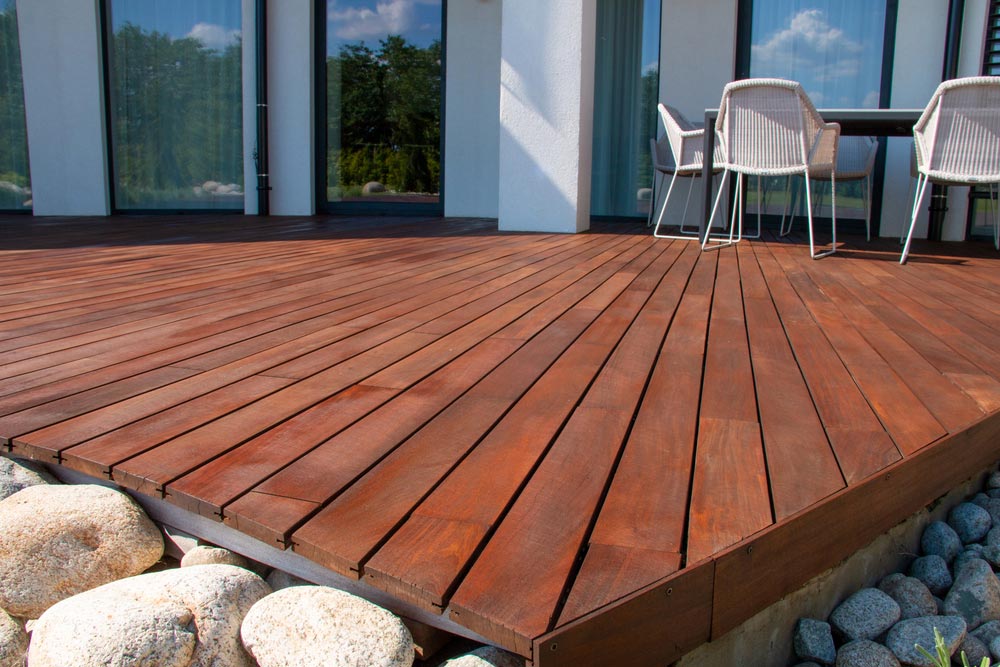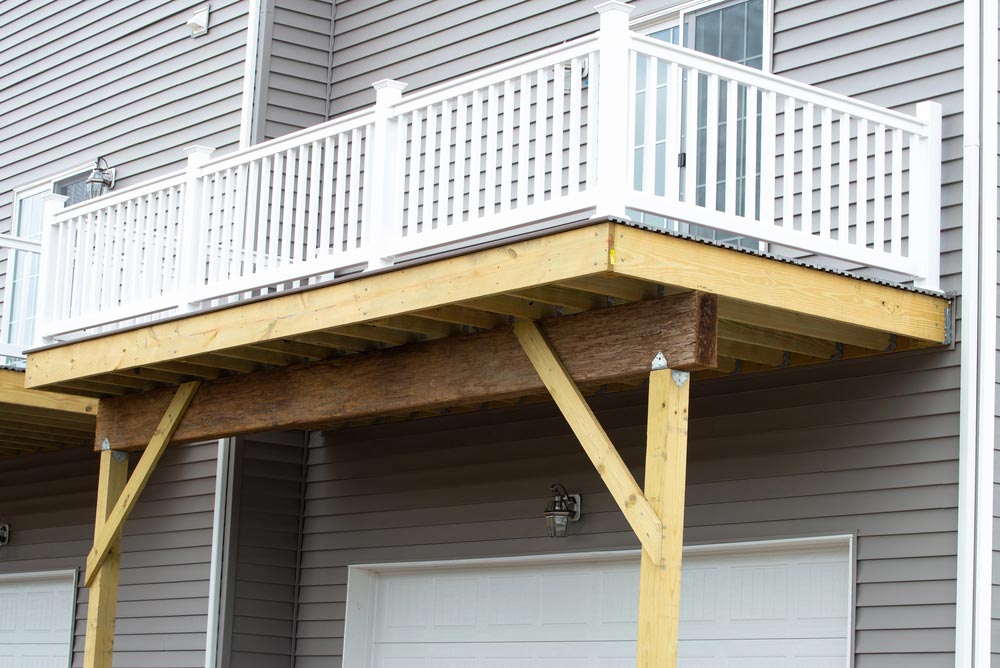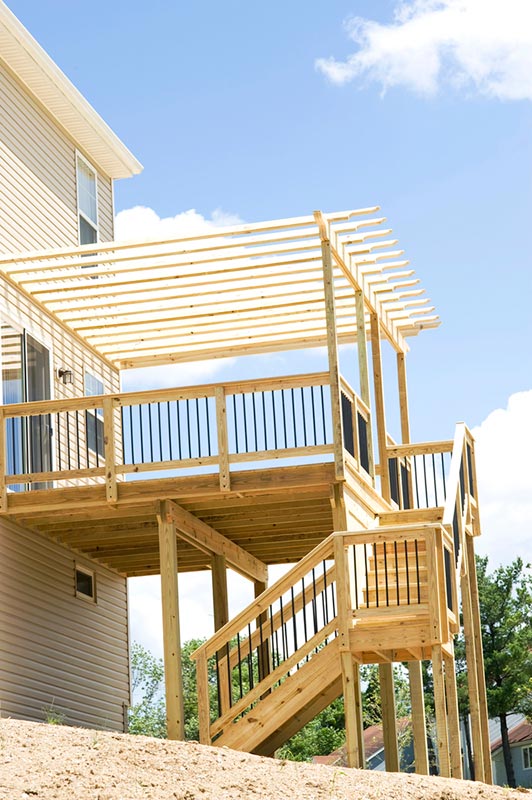If you’re thinking about adding a deck to your home, you probably have a lot of questions. Do you need a permit, and can you build it yourself? You may also wonder what materials are most suitable for your deck installation.
Residential decks require specific preparations to make sure they’re built correctly and according to code, but the benefits of a completed deck outweigh the time and costs associated with preparation and building.
The Benefits of Adding a Deck to Your Home
Some of the benefits of adding a residential deck include the following:
- It will give you a beautiful and inviting outdoor living space on which you can spend time with family and friends.
- It can improve your home’s resale value.
- It can add more functionality to your backyard.
Be sure to speak to a professional for more information.

Code Requirements for Residential Decks
Residential decks have specific code requirements that you must research before you confirm your deck design and start the building process. Some of them are locally enforced, so be sure to check with the appropriate government agency to make sure your deck and railing meet these requirements.
Decks that are built higher than 30 inches off the ground will need to have a railing. Otherwise, it’s optional. But there may be some other reasons why you may want to add a railing to your deck. Some of them can include the following:
- It can add another dimension of style to your deck.
- It can keep people from stepping off the edge of your deck and into the landscaping.
- It can help guests feel more comfortable if they move closer to the edge of the deck.
- It can keep young children from falling off the deck.
Once you have confirmed your deck design, you will most likely need to get a building permit from your local town or city hall before you can start building. Be sure to bring a diagram of your proposed deck design with the proper dimensions so you can get the right permit. If you work with a contractor, this person will be able to guide you through the process.

Cost Considerations for Residential Decks
Budget is one of the most important considerations when planning a residential deck installation. There are several cost factors that you’ll need to take into consideration, which can be either up front or over the long term.
Here are some of the upfront costs that you should think about as you plan your build:
- Labor — This is often the costliest part of the build.
- Design — A more complex deck design will cost more to build.
- Substructure — A complicated deck will require a more intricate substructure than a simpler design.
- Deck Materials — Upfront costs for deck materials are only part of the story. Some deck and railing materials may cost you more in the long run.
- Fasteners — Some types of fasteners will have a higher price than others.
Some of the long-term cost considerations include the following:
- How much maintenance you’ll be required to do.
- How prone your deck will be to repairs or replacements.
Be sure to speak to a professional for more information about the costs associated with a deck installation.
Choosing the Best Material for Your Deck
You want to choose a deck material that will look like real wood but will also be able to withstand the elements. Wood won’t be your best choice, but you want to look at all your options so you can find the best solution for you. Be sure to speak to a professional for more advice.

Factors That Can Affect Deck Size and Shape
If you plan to build a deck or extend an existing one, size and shape will be an important consideration. But because there are so many possibilities, how do you know what size and shape is right for you? Here are some factors you should consider as you plan your deck installation:
- Available Space — Your deck should make the most of the space around it and create a seamless transition from your home to your yard.
- Deck Function — How you plan to use your deck will play an important role in its design.
- Home Architectural Style —Your deck design should complement your home’s architectural style.
Residential Decks FAQ
Do I need to be careful about using a grill, patio heater, or any other heat source on my deck?
You should exercise extreme caution while using any heat source on a deck or screen porch. If you’re using a grill or patio heater, you need to make sure it’s far enough away from the railings, house, or any other structure that may come into contact with the heating element.
Some grill and patio heaters can reach temperatures of over 800 degrees, which can cause severe damage to any structure. You should always read the manufacturer’s instructions about how to place the heat source you want to use on your deck. You never want to leave a heat source unattended, and make sure you do the proper maintenance.
Should I place a mat under my grill?
Grilling is one of the most common causes of deck and patio stains. Grease stains are hard to get rid of. And in most cases, they will be permanent if they’re not taken care of quickly enough. You can find a grilling mat at any hardware store, but you can also purchase one online. If you drop something on your deck, be sure to clean up the grease stain immediately. You can use any household degreaser, but check with the deck’s manufacturer for any tips or suggestions about cleaning.
Are there any regulations in Texas about deck designs?
While you’re designing a deck in the State of Texas, you need to take several specifications into consideration. In Texas, the size of your deck can determine if you need a permit. Decks under 200 square feet may not require a permit, but you always want to check with the appropriate government office in your area to make sure.
If the deck is over 200 square feet but is less than 1,000 square feet, you will usually be required to get a general repair permit. And any deck that’s more than 30 inches above grade at any point will require a permit regardless of size. It will also need to have some extra safety features (such as deck railings). If the stairway has more than four risers, you will be required to install handrails. Ramps must have a maximum slope of 1:12. They must also have handrails if they rise above six inches.
If the deck is more than 1,000 square feet, it’s considered an addition (which will require a full permit application). Other factors about location (such as proximity to property lines, easements, and other existing structures) are also important. You want to make sure the deck doesn’t interfere with these areas.
If the property is a duplex or has more than two family dwelling units, the regulations about deck designs may be stricter and can involve limitations on deck size or fire safety measures. Decks that are attached to sheds or other accessory structures may also have different permitting requirements compared to standard decks. You always want to check with the city office in your area for more information.
What is the permit application process in the State of Texas?
Here is a breakdown of each step in applying for a building permit:
- Preparing your site plan — This should include your property’s dimensions, as well as the location of your home and any other structures. It should also show the proposed size and location of your new deck, as well as any property lines and easements.
- Completing the permit application — It will require you to provide information about the property owner, the contractor (if you’re using one), as well as any specifics of the construction project.
- Submitting your application — Once you have completed the application, you need to submit it to your local building department. In most cases, you can do it online. But some areas will require you to submit your application in person.
- Paying the permit fee — When you submit your application, you will also need to pay a permit fee. The exact amount will depend on the size and complexity of your deck project.
- Waiting for approval — After you have submitted your application and paid the permit fee, you’ll need to wait for approval. The review process can take anywhere from a few days to a few weeks (depending on your local building department).
Once your permit has been approved, you can start the construction process. But everything must comply with the approved plans and local building codes. Your deck will also have to be evaluated by an inspector to make sure it complies with the approved plans and building codes. Once the construction has been completed, a final inspection will be required.
If you’re looking for a quality deck installation company in Corpus Christi, be sure to get in touch with Bayfront Roofing. We have a team of experienced professionals who would be more than happy to speak with you about your specific needs.